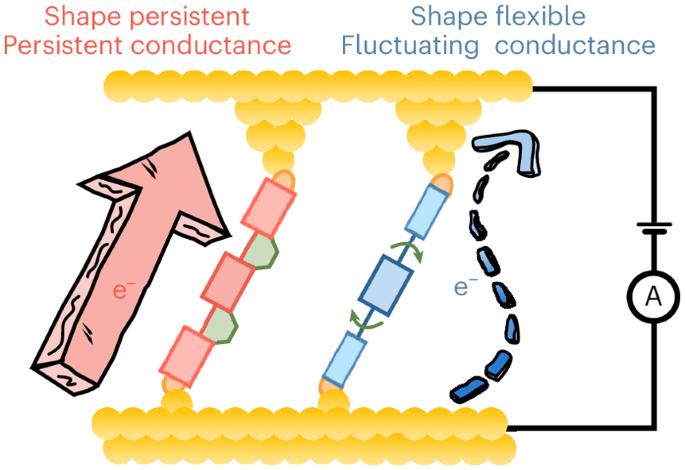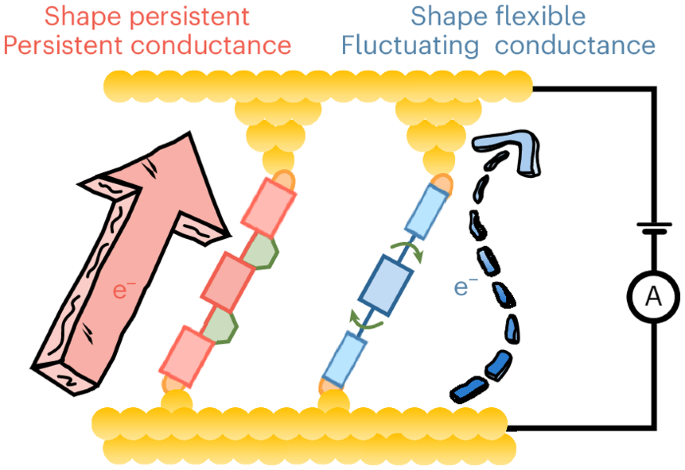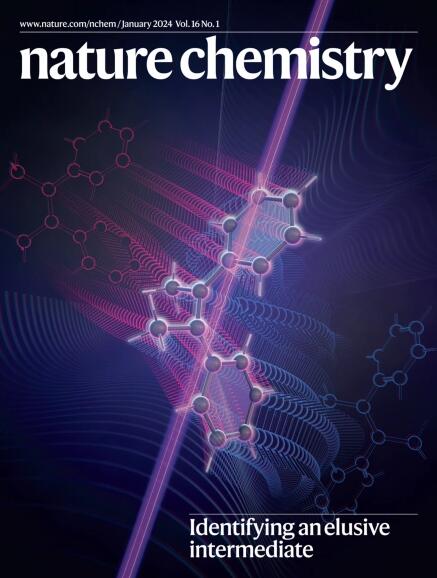形状持久的梯形分子在单分子结中表现出与纳米间隙无关的传导性。
IF 19.2
1区 化学
Q1 CHEMISTRY, MULTIDISCIPLINARY
引用次数: 0
摘要
分子电子器件需要精确控制单分子中的电流流动。然而,单分子的电子传输特性关键取决于纳米级连接中的动态分子构象。在此,我们报告了一种利用形状持久分子控制分子电导的独特策略。通过单锅多组分梯形化策略合成的化学性质不同的带电梯形分子显示出与结位移几乎无关的分子电导(d[log(G/G0)]/dx ≈ -0.1 nm-1),与非梯形类似物观察到的依赖于纳米间隙的电导(d[log(G/G0)]/dx ≈ -7 nm-1)形成鲜明对比。梯形分子在动态交界位移过程中显示出异常狭窄的分子电导分布,这归因于形状持久的骨架和末端锚基团的旋转受限。这些原理进一步扩展到蝴蝶状分子,从而证明了该策略在实现与间隙无关的传导性方面的通用性。总之,我们的工作为利用形状持久分子控制分子电导提供了重要途径。本文章由计算机程序翻译,如有差异,请以英文原文为准。


Shape-persistent ladder molecules exhibit nanogap-independent conductance in single-molecule junctions
Molecular electronic devices require precise control over the flow of current in single molecules. However, the electron transport properties of single molecules critically depend on dynamic molecular conformations in nanoscale junctions. Here we report a unique strategy for controlling molecular conductance using shape-persistent molecules. Chemically diverse, charged ladder molecules, synthesized via a one-pot multicomponent ladderization strategy, show a molecular conductance (d[log(G/G0)]/dx ≈ −0.1 nm−1) that is nearly independent of junction displacement, in stark contrast to the nanogap-dependent conductance (d[log(G/G0)]/dx ≈ −7 nm−1) observed for non-ladder analogues. Ladder molecules show an unusually narrow distribution of molecular conductance during dynamic junction displacement, which is attributed to the shape-persistent backbone and restricted rotation of terminal anchor groups. These principles are further extended to a butterfly-like molecule, thereby demonstrating the strategy’s generality for achieving gap-independent conductance. Overall, our work provides important avenues for controlling molecular conductance using shape-persistent molecules. Achieving robust and controllable conductance in single-molecule junctions is challenging due to the dynamic nature of molecular conformations that fluctuate over operational timescales. A strategy using shape-persistent molecules has now been developed that demonstrates nearly junction-displacement-independent conductance, providing a stable solution for single-molecule electronic properties.
求助全文
通过发布文献求助,成功后即可免费获取论文全文。
去求助
来源期刊

Nature chemistry
化学-化学综合
CiteScore
29.60
自引率
1.40%
发文量
226
审稿时长
1.7 months
期刊介绍:
Nature Chemistry is a monthly journal that publishes groundbreaking and significant research in all areas of chemistry. It covers traditional subjects such as analytical, inorganic, organic, and physical chemistry, as well as a wide range of other topics including catalysis, computational and theoretical chemistry, and environmental chemistry.
The journal also features interdisciplinary research at the interface of chemistry with biology, materials science, nanotechnology, and physics. Manuscripts detailing such multidisciplinary work are encouraged, as long as the central theme pertains to chemistry.
Aside from primary research, Nature Chemistry publishes review articles, news and views, research highlights from other journals, commentaries, book reviews, correspondence, and analysis of the broader chemical landscape. It also addresses crucial issues related to education, funding, policy, intellectual property, and the societal impact of chemistry.
Nature Chemistry is dedicated to ensuring the highest standards of original research through a fair and rigorous review process. It offers authors maximum visibility for their papers, access to a broad readership, exceptional copy editing and production standards, rapid publication, and independence from academic societies and other vested interests.
Overall, Nature Chemistry aims to be the authoritative voice of the global chemical community.
 求助内容:
求助内容: 应助结果提醒方式:
应助结果提醒方式:


